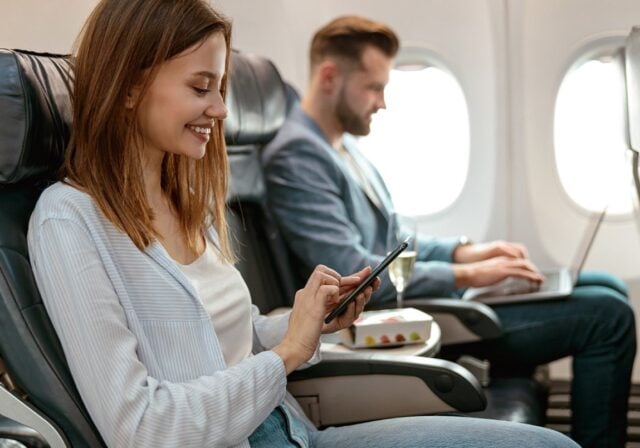It's perhaps the biggest luxury afforded to airline passengers, especially to passengers stuck in coach. In this article, we are going to explore how airplane Wi-Fi works, factors affecting airplane Wi-Fi quality, 5 steps to connect to airplane Wi-Fi, and how to get Wi-Fi for free.
Do airplanes have Wi-Fi?
Put simply, yes – many airplanes do have Wi-Fi for passengers. In fact, in-flight connectivity has become increasingly common, especially on major carriers and long-haul routes. Whether you're flying domestically or internationally, there's a good chance your flight has some form of internet access available.
However, the availability, speed, and overall quality of your connection can vary based on several factors – most notably, your airline, your aircraft type and age, your flight route, and the technology used onboard – which we’ll get into more below.
What factors affect airplane Wi-Fi quality?
Several factors can impact the quality of your in-flight Wi-Fi. Here are five:
- Flight location: Flying over land? You’re likely to have a stronger, more stable connection, especially if your airline uses an air-to-ground network. When you’re over oceans or remote areas where there are no cell towers, the connection often relies solely on satellites, which can be slower or more prone to interruptions.
- Altitude and speed: The faster and higher you go, the harder the system has to work to maintain a steady connection. Most systems are designed for cruising altitude, so don’t expect much until you're in the air and leveled off.
- Weather conditions: Bad weather can impact more than just your travel schedule, as it can interfere with the satellite signal too.
- Network congestion: Just like a coffee shop’s Wi-Fi can slow things down when a lot of people are connected, airplane Wi-Fi can get bogged down when too many passengers are trying to stream, email, and connect all at once.
- The technology on board: Not all aircraft are created equal. Some planes are equipped with cutting-edge satellite tech, while others are working with more basic systems.
How does airplane Wi-Fi work?
While getting a signal on the ground makes perfect sense, how does it work in a commercial aircraft that’s bolting through the sky at cruising speeds of up to 575 miles per hour—tens of thousands of feet in the air? There are two ways:
- Air-to-ground (ATG) network. With this type of network, the underside of the plane is equipped with antennas that connect with the closest tower on the ground. The signal goes to the cabin server, then to the on-board router, transforming the plane into a hotspot for passengers. The downsides of this method, however, are obvious: the plane has to be over land (or close to it) to work well. Sure, you may be able to do basic stuff like check an email or send an IM, but not much more, especially on international flights.
- Satellite network. Like ATGs, this method also utilizes antennas, but they’re mounted on the top of the aircraft and they connect to a network of satellites (whichever satellite is closest) as the plane travels. The signal makes its way to the on-board server, through a Wi-Fi router and then to you. Satellite service uses both narrowband and broadband networks to give you full internet access. What narrowband lacks in its ability to accommodate steaming movies, playing video games, and the like, broadband somewhat makes up for.
How to connect to airplane Wi-Fi: 5 common steps
How you get online will vary from airline to airline, but it’s usually pretty straightforward and only requires a few steps. Here's a five-step guide:
- Use Airplane Mode: Place your device in airplane mode; you’ll need to do this before you connect to the airline’s in-flight Wi-Fi.
- Connect to the Wi-Fi network: Select the in-flight network. It’ll usually be named after the airline (e.g., “DeltaWiFi” or “AA-Inflight”).
- Open a browser: Most airlines redirect you to their Wi-Fi portal automatically. If not, try typing in a basic site like “www.google.com” and you’ll be redirected.
- Purchase or log in: You might need to pay for access or log in with your frequent flyer account. Some airlines also offer free messaging or limited free browsing, depending on your route and membership status.
- Get connected: You should now be able to browse emails, news articles, or watch episodes of your favorite show.
Bonus tip: If your flight has an app (many do), download it before you fly. Some airlines only allow streaming or entertainment access through their official app.
Is Wi-Fi free on airplanes?
Whether you’ll have access to free Wi-Fi depends on the airline you choose and various other factors. Here’s a look at four possible Wi-Fi scenarios:
- Free for everyone: A few airlines, like JetBlue, offer (or are soon planning to offer) free Wi-Fi on flights. Some may come with time or data limits. Be sure to check with your airline ahead of time so you know in advance.
- Free for loyalty members: Many airlines offer complimentary access to elite members or credit card holders. Some even give free messaging for all passengers, regardless of status. In addition, some internet service providers, like T-Mobile, partner with airlines like Alaska, American, Delta, and United to offer free Wi-Fi on most domestic flights to customers on certain plans.
- Paid access: On some flights, Wi-Fi is still a pay-to-play situation. Rates can range from a few dollars for short flights to upwards of $20 for long-haul international routes.
- Subscriptions: Some airlines offer Wi-Fi subscription plan, which may be worth investing in if you fly often.
Always check your airline’s Wi-Fi policy before you fly - and be sure to look for free Wi-Fi perks via your credit card, internet provider, or hotel loyalty program.
Connecting to airplane Wi-Fi: The bottom line
Airplane Wi-Fi has come a long way, evolving from a rare luxury to an expected amenity on many flights. While connection quality and cost still vary depending on the airline, flight path, and onboard technology, the trend is clear: more carriers are investing in faster, more reliable in-flight internet – and they’re increasingly offering it for free.
Knowing how airplane Wi-Fi works, how to get it for free, and what factors impact its performance can help you make the most of your time in the air.
You might also be interested in:
- Explore T-Mobile Travel Benefits
- T-Mobile In-Flight Wi-Fi
- What Is Data Roaming? A Guide to Managing Cellular Data Usage
- Stay Calm, Cool, and Connected with Our 7 Best Travel Gadgets
- How to Get Wi-Fi On the Go
- What is Streaming?
Sources:
https://aviex.goflexair.com/flight-school-training-faq/commercial-plane-speeds
https://www.airport-technology.com/features/how-does-wifi-work-on-a-plane
https://www.rd.com/article/wifi-on-planes
https://www.united.com/en/us/fly/travel-experience/inflight-wifi.html
https://www.aa.com/i18n/travel-info/experience/entertainment/wi-fi-and-connectivity.jsp
https://thepointsguy.com/guide/airlines-free-wi-fi
https://upgradedpoints.com/travel/airlines/how-airplane-wi-fi-works





